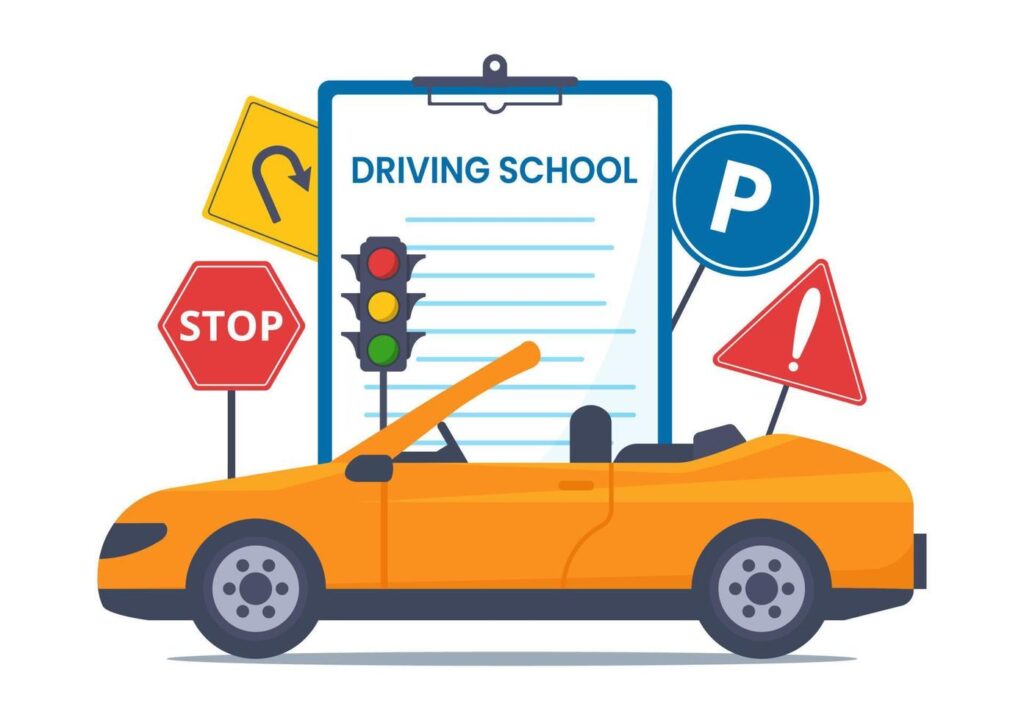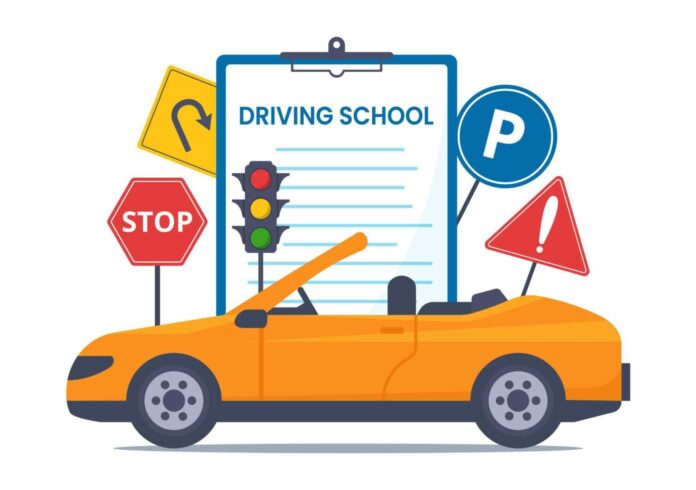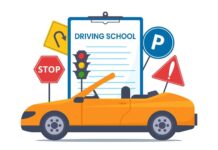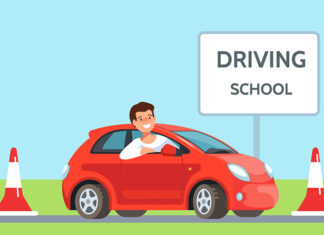Getting behind the wheel represents freedom, independence, and a new chapter of possibilities. But before you hit the open road, proper training and a valid license are crucial for ensuring your safety and the safety of others. This comprehensive guide explores everything you need to know about driving school training and getting your license.
Driving is a complex skill that demands more than just knowing how to operate a vehicle. Skilled driving involves mastering road rules, maneuvering techniques, and defensive strategies, and developing exceptional situational awareness.
Enrolling in a driving school equips you with the necessary knowledge and practical experience to navigate the roads confidently. A valid license, obtained after passing a driving test, is a legal requirement that demonstrates your competence behind the wheel.

I. Types of Driving Schools
A. Accredited driving schools and their benefits:
Accredited driving schools adhere to rigorous government-approved curriculum standards. These schools offer comprehensive training programs delivered by certified instructors. Benefits include:
- Structured learning: A well-defined curriculum ensures a systematic approach to learning, covering all essential aspects of driving.
- Qualified instructors: Certified instructors possess extensive experience and knowledge to guide you effectively.
- Dual-control vehicles: These specially equipped vehicles provide instructors with the ability to intervene if necessary for safety reasons.
- Standardized testing: Accredited schools often have close ties with licensing agencies, streamlining the testing process.
B. Online driving schools and their convenience:
While traditional in-person instruction remains the gold standard, online driving schools are gaining popularity. These courses typically offer:
- Flexibility: Learn at your own pace, anytime, anywhere, with internet access.
- Interactive learning: Online modules may incorporate videos, animations, and quizzes to enhance engagement.
- Cost-effectiveness: Online courses are often more affordable than traditional programs.
Keep in mind: Online driving schools typically only cover the theoretical knowledge component. You’ll likely still need to enroll with a driving school or instructor for hands-on behind-the-wheel training.
II. Driving School Training Programs
A. Behind-the-wheel training and its significance:
This is the core of driving school training, allowing you to practice essential skills in a controlled environment. Expect to learn:
- Vehicle operation: Starting, stopping, steering, gear shifting (manual transmission if applicable), and basic maneuvering.
- Traffic signals and road rules: Understanding and obeying traffic signs, signals, and road markings is crucial for safe driving.
- Safe driving practices: This includes learning proper braking techniques, maintaining following distances, staying focused, and sharing the road responsibly.
Behind-the-wheel training allows you to build confidence, develop muscle memory, and master the practical application of theoretical knowledge.
B. Classroom instruction and theoretical knowledge:
Classroom sessions lay the foundation for your driving experience. These cover essential topics like:
- The Rules of the Road: Understanding traffic laws, right-of-way, and penalties is crucial for responsible driving.
- Vehicle maintenance: Basic knowledge about car maintenance allows you to identify potential problems and ensure your vehicle is roadworthy.
- Defensive driving techniques: Learning how to anticipate and react to hazardous situations is key to avoiding accidents.
Solid theoretical knowledge combined with practical skills makes you a well-rounded and safe driver.
III. Licensing Process
A. Obtaining a learner’s permit and its requirements:
The first step to getting your license is securing a learner’s permit. Requirements vary by region but typically involve:
- Completing a vision test to ensure adequate eyesight.
- Passing a written knowledge test demonstrating your understanding of traffic rules and road signs.
- Paying a licensing fee.
B. Practical driving test preparation and tips:
Once you’ve completed your driving school training and have your learner’s permit, you’re eligible for the practical driving test. Here are some tips to prepare:
- Practice regularly: Consistent practice with a qualified instructor or licensed driver (depending on regulations) is key to building confidence and perfecting your skills.
- Review the test route: If possible, familiarize yourself with the designated test route in advance to manage any anxieties.
- Focus on weak areas: Identify areas where you feel less confident and dedicate extra practice time to them.
- Stay calm and focused: Nervousness can lead to mistakes. Take deep breaths and concentrate on demonstrating your best driving abilities.
C. Road sign and traffic rule knowledge evaluation:
The practical driving test typically combines an evaluation of your ability to navigate traffic scenarios and demonstrate proper following of traffic signs and rules.
IV. Choosing the Right Driving School
A. Factors to consider when selecting a driving school:
- Accreditation: Choose a school accredited by a reputable government agency to ensure quality training.
- Curriculum: Evaluate the curriculum to ensure it covers all essential aspects of driving, including both theoretical knowledge and practical skills.
- Instructor qualifications: Look for experienced, certified instructors with a good track record of student success.
- Vehicle condition: Ensure the driving school uses well-maintained and insured vehicles.
- Cost and package options: Compare costs and choose a package that fits your budget and learning needs.
B. Reviews and recommendations for reliable options:
Reading online reviews and seeking recommendations from friends and family who have recently obtained their licenses can offer valuable insights.
C. Comparing prices and course offerings:
Don’t solely base your decision on price. Compare the curriculum, instructor qualifications, and additional features offered by different schools before making a choice.
V. Advanced Training and Specializations
A. Defensive driving courses and their benefits:
Defensive driving courses teach strategies for anticipating and avoiding potential hazards on the road. Benefits include:
- Enhanced awareness: You’ll learn to identify dangerous driving behaviors and develop strategies to mitigate risks.
- Improved skills: Refine your maneuvering abilities and decision-making skills in challenging situations.
B. Advanced maneuvering techniques and skills:
Some driving schools offer advanced training courses focusing on specific skills like:
- Highway driving: Mastering lane changes, maintaining proper following distances and navigating high-speed traffic.
- Night driving: Learn how to adjust your driving techniques for low-visibility conditions.
- Parking: Perfecting parallel parking, reverse parking, and other parking maneuvers.
C. Specialized training for specific driving conditions:
Specific training options may be available for drivers who frequently encounter challenging situations like:
- Off-road driving: Learn techniques for navigating rough terrain safely.
- Towing trailers or caravans: Understanding the additional considerations and techniques involved in towing.
VI. FAQs and Common Concerns
A. Answering common questions regarding driving school training:
- How long does driving school typically last? The duration varies depending on the program chosen but usually ranges from a few weeks to a few months.
- What happens if I fail the driving test? Don’t worry! You can usually retake the test after a waiting period and additional practice.
- Can I learn to drive without a driving school? While technically possible in some regions, it’s strongly recommended to enroll in a driving school for proper training and guidance.
VII. Conclusion
Driving is a privilege, not a right. Investing in proper driving school training equips you with the skills, knowledge, and confidence to navigate the roads safely and responsibly. A valid license serves as official recognition of your competence and ensures safe driving for yourself and others.
Don’t wait! Take the first step towards your driving freedom. Research driving schools in your area, compare their offerings, and choose the one that best suits your needs. With the right training and dedication, you’ll be cruising down the road in confidence before you know it.
Why Choose Sharp Drives Driving School?
In addition to the benefits of traditional driving school training, Sharp Drive offers several advantages to help you excel on your driving journey:
- Learn First and Pay Later: Focus on learning without the immediate financial burden. Pay for your training after you’ve successfully obtained your license.
- Professional and Punctual Instructors: Sharp Drive instructors are highly qualified, reliable, and committed to your success. They arrive on time for lessons, ensuring efficient use of your learning time.
- 15+ Years of Experience: Benefit from the expertise of seasoned instructors with over 15 years of experience in guiding students toward confident driving.
- Unique Training Techniques: Sharp Drive instructors are trained using the latest and most effective methods developed by Sharp Drives. These techniques are designed to make learning easier, faster, and more enjoyable.
Sharp Drives Driving School: Your Gateway to Confident Driving
Looking for the best driving school in Bangalore for the best driving school training and getting your license? Look no further than Sharp Drive! With our commitment to quality instruction, flexible payment options, and experienced professionals, we’ll equip you with the skills and knowledge to navigate the roads with confidence.














